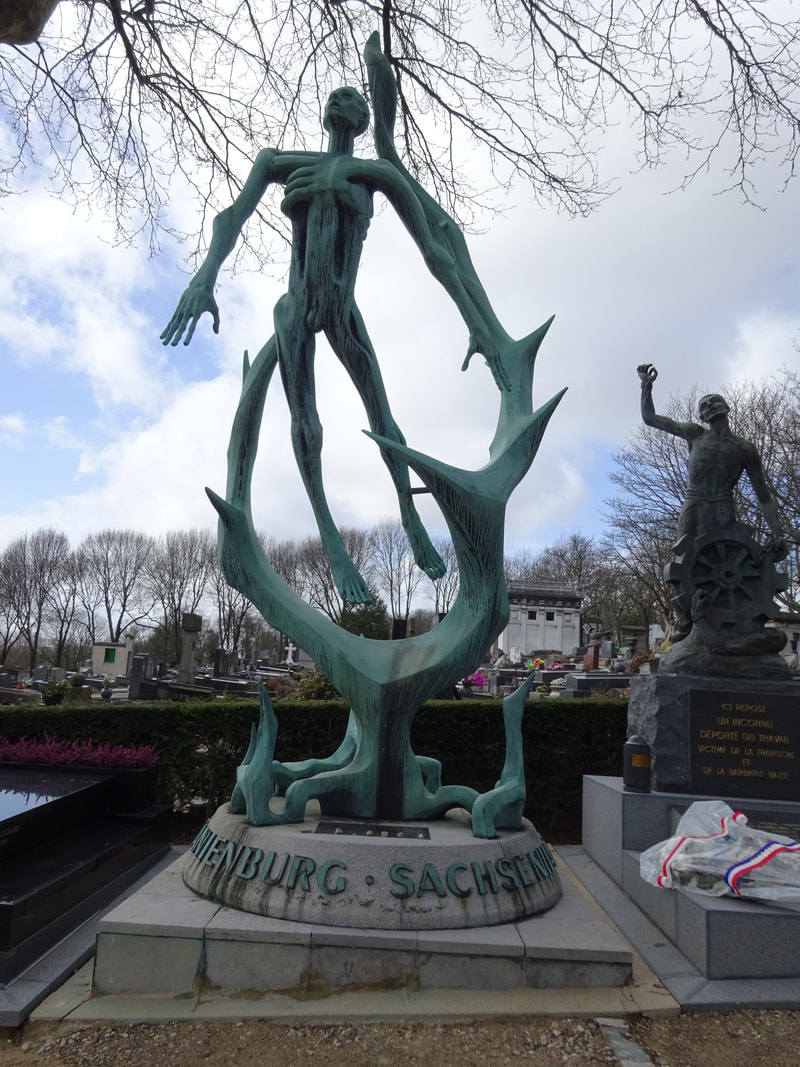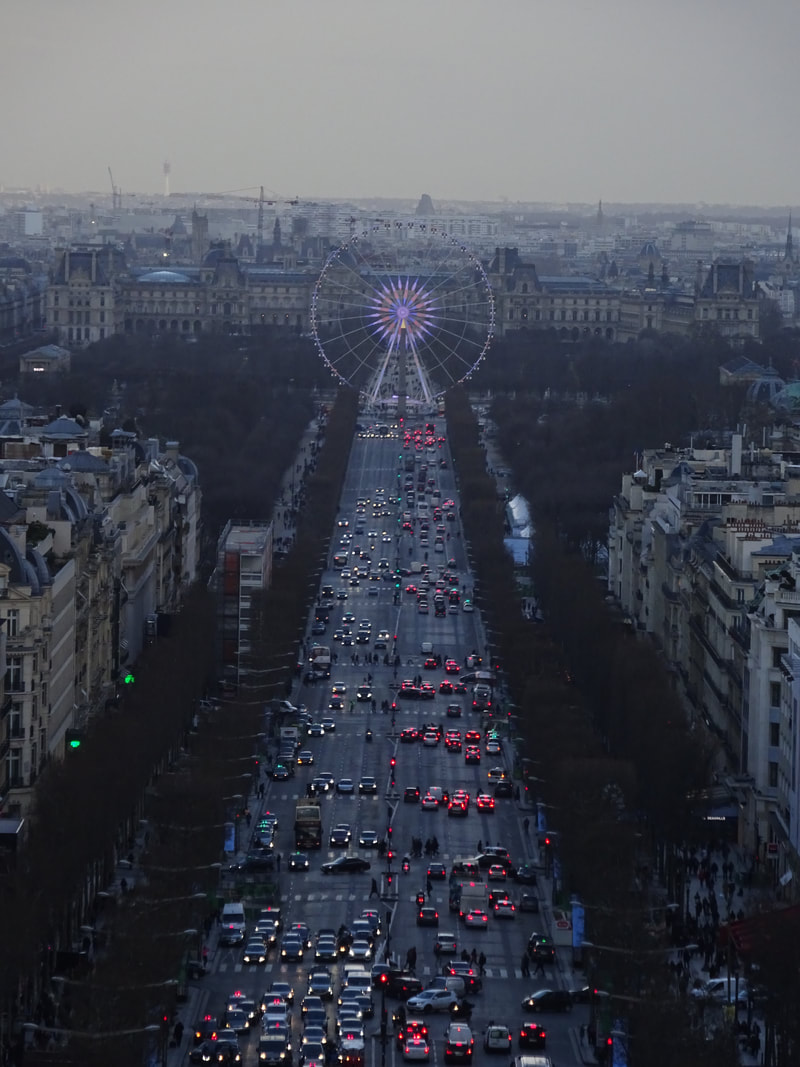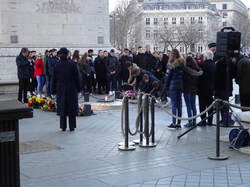16 March 2018
Père Lachaise Cemetery is the largest cemetery in Paris (44 hectares or 110 acres). With more than 3.5 million visitors annually, it is the most visited necropolis in the world.
Tomb of Oscar Wilde - from the 1990's visitors have felt compelled to kiss it leaving red lipstick imprints - cleaning was becoming damaging, so in 2011 it was protected with plexiglass.
The cemetary holds many memorials to "grave" events - below left the Holocaust.
On the right, is the grave of Gilbert Morard - a senior executive/engineer for French train transit - you're supposed to leave a train ticket upon his tomb.
On the right, is the grave of Gilbert Morard - a senior executive/engineer for French train transit - you're supposed to leave a train ticket upon his tomb.
To the left, Chopin (1810-1839): his music, his status as one of music's earliest superstars, his (indirect) association with political insurrection, his high-profile love-life, and his early death have made him a leading symbol of the Romantic era.
To the right, kinda eerie, a life-size statue of the deceased:
Dominique Vivant, Baron Denon (4 January 1747 – 27 April 1825) was a French artist, writer, diplomat, author, and archaeologist. He was appointed as the first Director of the Louvre museum.
To the right, kinda eerie, a life-size statue of the deceased:
Dominique Vivant, Baron Denon (4 January 1747 – 27 April 1825) was a French artist, writer, diplomat, author, and archaeologist. He was appointed as the first Director of the Louvre museum.
Interesting memorials: to the left, the only lettering that's legible says "Manes" - In ancient Roman religion, the Manes are deities sometimes thought to represent souls of deceased loved ones; to the right, "France Remembers", a memorial to lost soldiers apparently.
"Gioachino Antonio Rossini's opera Barber of Seville is one of the greatest masterpieces of comedy within music, after two hundred years, it remains a popular work."
Gerri plotting course for the subway to take us to the Sacré-Cœur Basilica - and back to the land of the living.
Gerri plotting course for the subway to take us to the Sacré-Cœur Basilica - and back to the land of the living.
"The Basilica of the Sacred Heart of Paris, commonly known as Sacré-Cœur Basilica and often simply Sacré-Cœur is a Roman Catholic church and minor basilica, dedicated to the Sacred Heart of Jesus. A popular landmark and the second most visited monument in Paris, the basilica is located at the summit of the butte Montmartre, the highest point in the city. Sacré-Cœur is a double monument, political and cultural, both a national penance for the defeat of France in the 1870 Franco-Prussian War and the socialist Paris Commune of 1871 crowning its most rebellious neighborhood, and an embodiment of conservative moral order, publicly dedicated to the Sacred Heart of Jesus, which was an increasingly popular vision of a loving and sympathetic Christ. Construction began in 1875 and was completed in 1914."
"Near the end of the 19th century and at the beginning of the twentieth many artists had studios or worked in or around Montmartre, including Amedeo Modigliani, Claude Monet, Pierre-Auguste Renoir, Edgar Degas, Henri de Toulouse-Lautrec, Suzanne Valadon, Piet Mondrian, Pablo Picasso, Camille Pissarro, and Vincent van Gogh."
The Moulin de la Galette is a windmill and associated businesses situated near the top of the district of Montmartre. Since the 17th century the windmill has been known for more than just its milling capabilities. Nineteenth-century owners and millers, the Debray family, made a brown bread, galette, which became popular and thus the name of the windmill and its businesses, which have included a famous guinguette and restaurant. In the 19th century, Le Moulin de la Galette represented diversion for Parisians seeking entertainment, a glass of wine and bread made from flour ground by the windmill. Artists, such as Renoir, van Gogh, and Pissarro have immortalized Le Moulin de la Galette; likely the most notable was Renoir's festive painting, Bal du moulin de la Galette.
A nearby mill (moulin) - this one red.
430 feet back down the hill.
"The Avenue des Champs-Elysée is an avenue 1.9 kilometres (1.2 mi) long and 70 metres (230 ft) wide, running between the Place de la Concorde and the Place Charles de Gaulle, where the Arc de Triomphe is located. It is known for its theaters, cafés, and luxury shops, for the annual Bastille Day military parade, and as the finish of the Tour de France cycle race. The name is French for the Elysian Fields, the paradise for dead heroes in Greek mythology. Champs-Elysée is widely regarded to be one of the most recognisable avenues in the world."
"The Arc de Triomphe de l'Étoile, Triumphal Arch of the Star, is one of the most famous monuments in Paris, standing at the western end of the Champs-Élysées at the center of Place Charles de Gaulle, formerly named Place de l'Étoile — the étoile or "star" of the juncture formed by its twelve radiating avenues.
The Arc de Triomphe honours those who fought and died for France in the French Revolutionary and Napoleonic Wars, with the names of all French victories and generals inscribed on its inner and outer surfaces. Beneath its vault lies the Tomb of the Unknown Soldier from World War I.
Inspired by the Arch of Titus in Rome, Italy, the Arc de Triomphe has an overall height of 50 metres (164 ft), width of 45 m (148 ft), and depth of 22 m (72 ft). Three weeks after the Paris victory parade in 1919 (marking the end of hostilities in World War I), Charles Godefroy flew his Nieuport biplane under the arch's primary vault, and others did it again in 1981 and 1991."
The Arc de Triomphe honours those who fought and died for France in the French Revolutionary and Napoleonic Wars, with the names of all French victories and generals inscribed on its inner and outer surfaces. Beneath its vault lies the Tomb of the Unknown Soldier from World War I.
Inspired by the Arch of Titus in Rome, Italy, the Arc de Triomphe has an overall height of 50 metres (164 ft), width of 45 m (148 ft), and depth of 22 m (72 ft). Three weeks after the Paris victory parade in 1919 (marking the end of hostilities in World War I), Charles Godefroy flew his Nieuport biplane under the arch's primary vault, and others did it again in 1981 and 1991."
We walked all the way to the top of the Arch and took photos just before sunset.
We sure are seeing the Eiffel Tower a lot today. On the way back to our lodging, we're really in the neighborhood of the Tower, we paused to enjoy the nighttime lighting.









































 RSS Feed
RSS Feed
